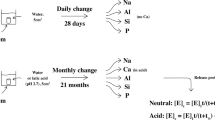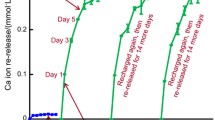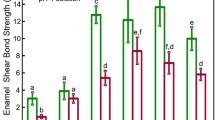Abstract
The potential of employing zinc polycarboxylate dental cement as a controlled release material has been studied. Benzalkonium chloride was used as the active ingredient, and incorporated at concentrations of 1, 2 and 3% by mass within the cement. At these levels, there was no observable effect on the speed of setting. Release was followed using an ion-selective electrode to determine changes in chloride ion concentration with time. This technique showed that the additive was released when the cured cement was placed in water, with release occurring by a diffusion mechanism for the first 3 h, but continuing beyond that for up to 1 week. Diffusion coefficients were in the range 5.62 × 10−6 cm2 s−1 (for 1% concentration) to 10.90 × 10−6 cm2 s−1 (for 3% concentration). Up to 3% of the total loading of benzalkonium chloride was released from the zinc polycarboxylate after a week, which is similar to that found in previous studies with glass-ionomer cement. It is concluded that zinc polycarboxylate cement is capable of acting as a useful material for the controlled release of active organic compounds.



Similar content being viewed by others
References
Wilson AD, Nicholson JW. Acid-base cements. Cambridge: The University Press; 1993.
Xie D, Faddah M, Park J-G. Novel amino acid modified zinc polycarboxylates for improved dental cements. Dent Mater. 2005;21:739–48.
Leloup JM, Serraj S, Pauvert B, Terol A. Chemical characterization of in vivo aged zinc polycarboxylate cements. J Mater Sci: Mater Med. 1998;9:493–6.
Nicholson JW, Hawkins SJ, Wasson EA. A study of the structure of zinc polycarboxylate cements. J Mater Sci: Mater Med. 1993;4:32–5.
Mount GJ. Color atlas of glass-ionomer cements. 3rd ed. London: Martin Dunitz; 2002.
Kydonieus A, editor. Treatise on controlled drug delivery. New York: Marcel Dekker; 1991.
Palmer G, Jones FH, Billington RW, Pearson GJ. Chlorhexidine release from an experimental glass ionomer cement. Biomaterials. 2004;25:5423–31.
Takahashi Y, Inazato S, Kaneshiro A, Ebisu S, Frencken J, Tay F. Antibacterial effects and physical properties of glass-ionomer cements containing chlorhexidine for the ART approach. Dent Mater. 2006;22:647–52.
Botelho MG. Compressive strength of glass ionomer cements with dental antibacterial agents. J South African Dent Assoc. 2004;59:51–3.
Botelho MG. Inhibitory effects on selected oral bacteria of antibacterial agents incorporated in a glass ionomer cement. Caries Res. 2003;37:108–14.
Jenkins S, Addy M, Wade W. The mechanism of action of chlorhexidine. A study of plaque growth on enamel inserts in vivo. J Clin Periodontol. 1988;15:415–24.
Marple B, Roland P, Benninger M. Safety review of benzalkonium chloride used as a preservative in intranasal solutions: an overview of conflicting data and options. Otolaryngology. 2004;30:131–41.
Pauloin T, Dutot M, Warnet J-M, Rat P. In vitro modulation of preservative toxicity: high molecular weight hyaluronan decreases apoptosis and oxidative stress induced by benzalkonium chloride. Eur J Pharm Sci. 2008;34:263–73.
British Pharmacopoeia, Vol. 1. H.M. Stationary Office: London; 1998. pp. 152–153, (8001-54-5).
Kuda T, Yano T, Kuda MT. Resistances to benzalkonium chloride of bacteria dried with food elements on stainless steel. J Food Sci Technol. 2008;41:988–93.
Xuea Y, Hiedaa Y, Kimurab K, Takayamaa K, Fujiharaa J, Tsujinoc Y. Kinetic characteristics and toxic effects of benzalkonium chloride following intravascular and oral administration in rats. J Chromatog. 2004;811:53–8.
Crank J, Park GS. Diffusion in polymers. London: Academic Press; 1968.
Nicholson JW. Studies in the setting of polyelectrolyte materials, Part 3: effect sodium salts on the setting and properties of glass polyalkenoate and zinc polycarboxylate dental cements. J Mater Sci: Mater Med. 1995;6:404–7.
Author information
Authors and Affiliations
Corresponding author
Rights and permissions
About this article
Cite this article
Ali, M.N., Edwards, M. & Nicholson, J.W. Zinc polycarboxylate dental cement for the controlled release of an active organic substance: proof of concept. J Mater Sci: Mater Med 21, 1249–1253 (2010). https://doi.org/10.1007/s10856-009-3957-0
Received:
Accepted:
Published:
Issue Date:
DOI: https://doi.org/10.1007/s10856-009-3957-0




